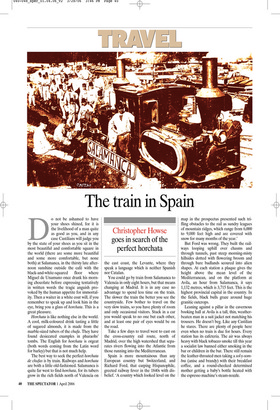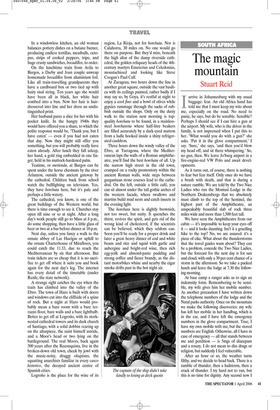The train in Spain
Christopher Howse goes in search of the perfect horchata
Do not be ashamed to have your shoes shined, for it is the livelihood of a man quite as good as you, and in any case Castilians will judge you by the state of your shoes as you sit in the most beautiful and comfortable square in the world (there are some more beautiful and some more comfortable, but none both) at Salamanca, in the thirsty late afternoon sunshine outside the café with the black-and-white-squared floor where Miguel de Unamuno once drank his morning chocolate before expressing tentatively in written words the tragic anguish provoked by the human appetite for immortality. Then a waiter in a white coat will, if you remember to speak up and look him in the eye, bring you a glass of horchata. This is a great pleasure.
Horchata is like nothing else in the world. A cool, milk-coloured drink tasting a little of sugared almonds, it is made from the marble-sized tubers of the chufa. They have found desiccated examples in pharaohs’ tombs. The English for horchata is orgeat (both words coming from the Latin word for barley) but that is not much help.
The best way to seek the perfect horchata de chufas is by train. Railways and horchata are both a little old-fashioned. Salamanca is quite far west to find horchata, for its tubers grow in the rich fields north of Valencia on the east coast, the Levante, where they speak a language which is neither Spanish nor Catalan.
You could go by train from Salamanca to Valencia in only eight hours, but that means changing at Madrid. It is in any case no advantage to spend less time on the train. The slower the train the better you see the countryside. Few bother to travel on the very slow trains, so you have plenty of room and only occasional visitors. Stuck in a car you would speak to no one but each other, and at least one pair of eyes would be on the road.
Take a few days to travel west to east on the cross-country rail route, north of Madrid, over the high watershed that separates rivers flowing into the Atlantic from those running into the Mediterranean.
Spain is more mountainous than any European country but Switzerland, and Richard Ford, that carping Hispanophile, greeted railway fever in the 1840s with disbelief. ‘A country which looked level on the map in the prospectus presented such trifling obstacles to the rail as sundry leagues of mountain ridges, which range from 6,000 to 9,000 feet high and are covered with snow for many months of the year.’ But Ford was wrong. They built the railways looping uphill over chasms and through tunnels, past steep morning-misty hillsides dotted with flowering broom and through bare badlands scoured into alien shapes. At each station a plaque gives the height above the mean level of the Mediterranean, and on the platform at Avila, an hour from Salamanca, it says 1,132 metres, which is 3,715 feet. This is the highest provincial capital in the country. In the fields, black bulls graze around huge granitic outcrops.
Leaning against a pillar in the cavernous booking hall at Avila is a tall, thin, weatherbeaten man in a suit jacket not matching his trousers. He doesn’t beg. Like any Castilian he stares. There are plenty of people here even when no train is due for hours. Every station has its cafeteria. The air was always heavy with black tobacco smoke till this year a socialist law banned either smoking in the bar or children in the bar. There still remain the leather-throated men taking a sol-y-sombra (anise and brandy) with their breakfast coffee, and a round-cheeked determined mother getting a baby’s bottle heated with the espresso machine’s steam-nozzle. In a windowless kitchen, an old woman balances pottery dishes on a butane burner, producing endless tortillas, meatballs, octopus, strips of cooked peppers, tripe, and huge crusty sandwiches, bocadillos, to order.
On the lunchtime train from Avila to Burgos, a Darby and Joan couple unwrap homemade bocadillos from aluminium foil. Like all train-travelling grandparents they have a cardboard box or two tied up with hairy sisal string. Ten years ago she would have been all in black, her white hair combed into a bun. Now her hair is hairdressered into line and her dress an undistinguished print.
Her husband pares a slice for her with his pocket knife. In the hungry 1940s they would have offered you a share, to which the polite response would be, ‘Thank you, but I have eaten’ — even if you had not eaten that day. Now they might still offer you something, but you will probably really have eaten already. After lunch they fall asleep, her hand, a gold ring embedded in one finger, held in his mattock-hardened palm.
Teatime, or merienda, at Burgos can be spent under the horse chestnuts by the river Arlanzon, outside the ancient gateway by the cathedral. Children back from school watch the bullfighting on television. Yes, they have horchata here, but it’s pale and perhaps a little watery.
The cathedral, you know, is one of the great buildings of the Western world, but there is time enough to see it. Churches stay open till nine or so at night. After a long day’s work people still go to Mass at 8 p.m., do some shopping, then have a little glass of beer or two at a bar before dinner at 10 p.m.
Next day, unless you fancy a walk to the ornate abbey of Las Huelgas or uphill to the ornate Charterhouse of Miraflores, you could catch the 11.33, due to reach the Mediterranean by six that afternoon. But train tickets are so cheap that it is no sacrifice to get off where it suits you and book again for the next day’s leg. The internet has every detail of the timetable (under Renfe, the state network).
A strange sight catches the eye when the train has climbed into the valley of the Ebro. The town of Haro is built with doors and windows cut into the cliffside of a spine of rock. But a night at Haro would probably mean a bare room with a bare terrazzo floor, bare walls and a bare lightbulb. Better to get off at Logroño, with its storknested cathedral towers and its dark church of Santiago, with a solid dobbin rearing up on the altarpiece, the saint himself astride, and a Moor’s head or two lying on the battleground. The real Moors, back again 500 years after the Reconquista, live in the broken-down old town, cheek by jowl with the music-noisy, druggy okupistas, the squatting anarchists familiar in every casco historico, the decayed ancient centre of Spanish cities.
Logroño is the place for the wine of its region, La Rioja, not for horchata. Nor is Calahorra, 30 miles on. No one would go there on purpose. But they’d miss, beneath the high altar of the damp riverside cathedral, the golden reliquary heads of the 4thcentury martyrs Emeterius and Celedonius, moustachioed and looking like Steve Coogan’s Paul Calf.
At Zaragoza, two hours down the line in another great square, outside the vast basilica with its ceilings painted, rather badly if I may say so, by Goya, it’s restful at night to enjoy a cool fino and a bowl of olives while gypsies rummage through the sacks of rubbish outside the shops. Only on the dusty walk to the station next morning is topquality horchata to be found, in a stainlesssteel horchateria where half-litre beakers are filled accurately by a dark-eyed matron from a ladle hooked inside a shiny refrigerated cauldron.
Three hours down the windy valley of the Ebro, at Tarragona, where the Mediterranean laps the walls of a Roman amphitheatre, you’ll find the best horchata of all. Up the narrow high street in the old town, cramped on a rocky promontory within the ancient Roman walls, wide steps between gargantuan stone courses lead to the cathedral. On the left, outside a little café, you can sit almost under the tall gothic arches of the western facade, where swallows and martins build mud nests and catch insects in the evening light.
The horchata here is slightly brownish, not too sweet, but nutty. It quenches the thirst, revives the spirit, and gets rid of the wrong kind of cholesterol, if the scientists can be believed, which they seldom can. Soon you’ll be ready for a proper drink and later a great heavy dinner of cod and white beans and rice and squid with garlic and aubergine and bright-red wine, then rich egg-yolk and almond-paste pudding and strong coffee and fierce brandy, as the distant motorbikes whine and nearby the cigar smoke drifts past in the hot night air.



























































































 Previous page
Previous page